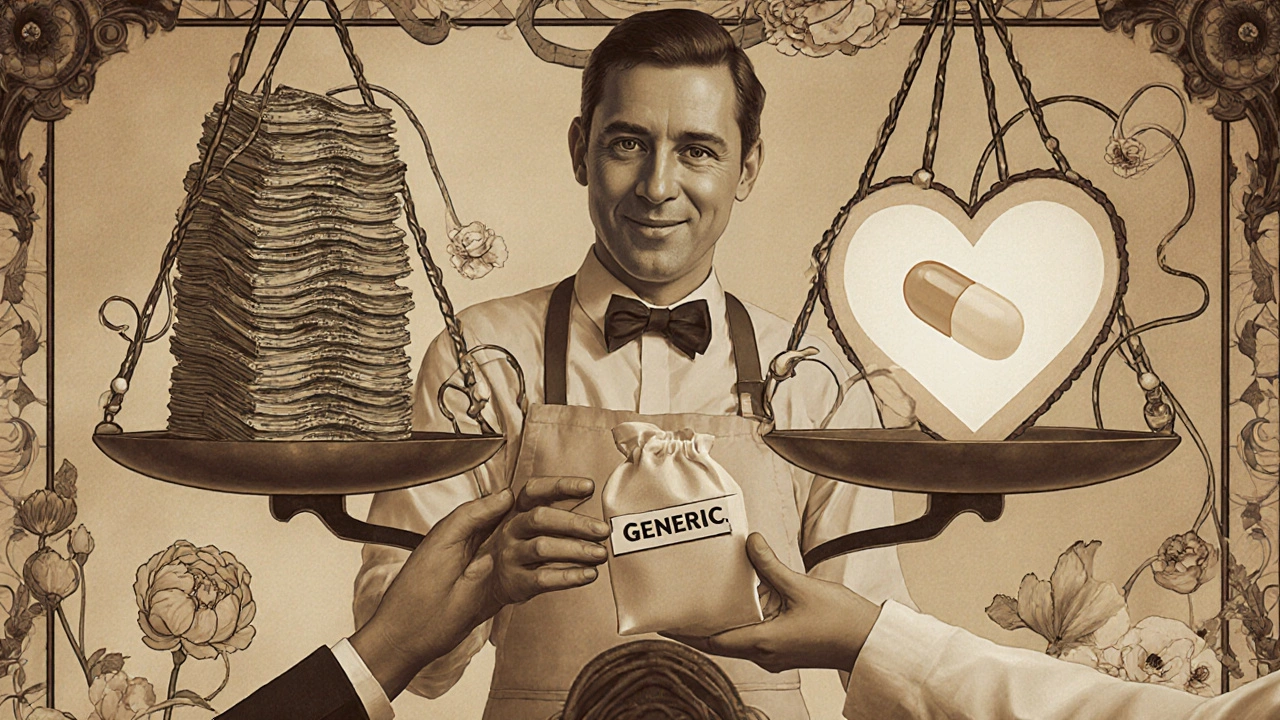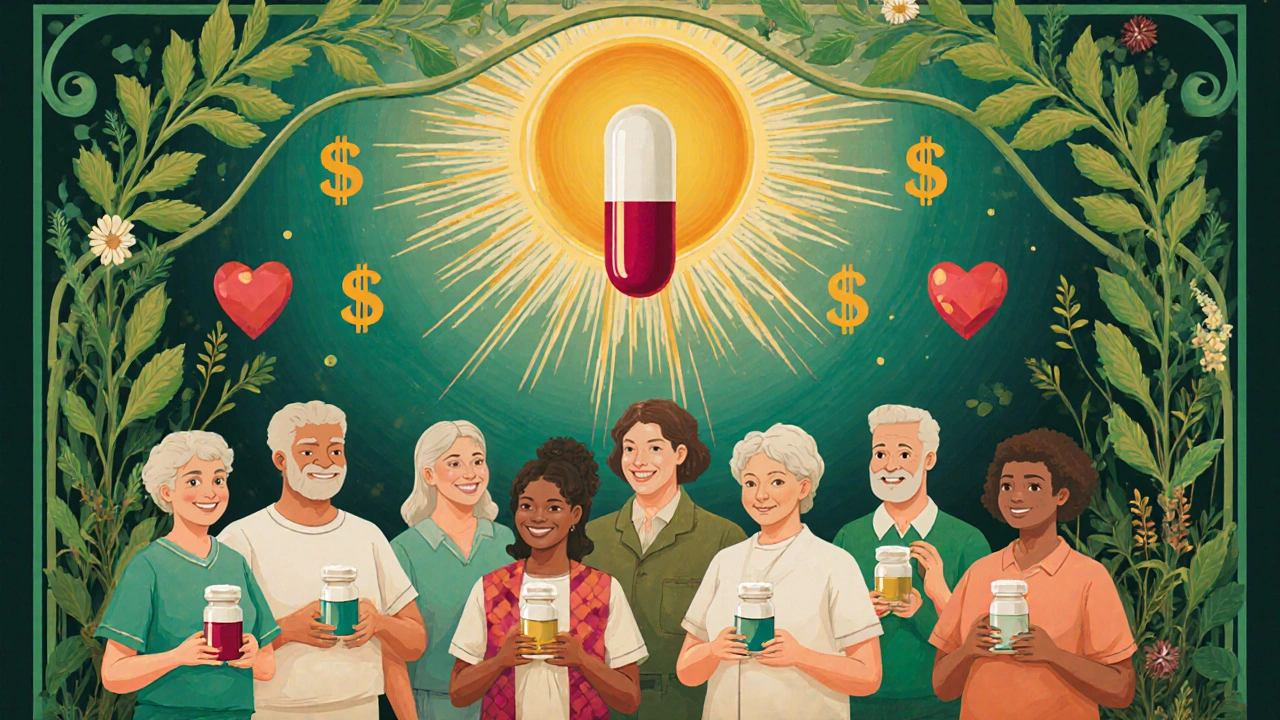Every year, millions of Americans face a tough choice: pay hundreds of dollars for a brand-name prescription or switch to a generic version that costs a fraction of the price. If you’ve ever wondered whether switching to generic medications is safe-or even smart-the answer is clear: generic medications are just as effective, just as safe, and dramatically cheaper than their brand-name counterparts. The fear that generics are "inferior" is a myth built on confusion, not science.
They’re the Same Drug, Just Cheaper
Generic medications contain the exact same active ingredient as the brand-name version. If your doctor prescribes Lipitor (atorvastatin), the generic version is still atorvastatin. Same molecule. Same chemical structure. Same way it works in your body. The U.S. Food and Drug Administration (FDA) doesn’t approve a generic drug unless it matches the brand-name drug in strength, dosage form, route of administration, and, most importantly, how quickly and completely your body absorbs it.This isn’t guesswork. The FDA requires generics to prove bioequivalence through rigorous testing. That means the generic version must deliver the same amount of medicine into your bloodstream at the same rate as the brand name. The acceptable range? Between 80% and 125% of the brand’s absorption levels. In real terms, that’s like two identical cars driving the same route at nearly identical speeds. One might have a slightly different paint job, but they both get you where you need to go.
Cost Savings Are Staggering
The biggest reason to switch? Money. Plain and simple.Generic drugs cost, on average, 80% to 85% less than brand-name versions. That’s not a small discount-it’s life-changing for people on fixed incomes or those without good insurance. Take warfarin, a common blood thinner. The brand-name version, Coumadin, can cost over $300 for a 30-day supply. The generic? Around $4. Or consider fexofenadine, the generic for Allegra. Brand: $30. Generic: $10. And it’s not just over-the-counter drugs. Even expensive prescriptions like statins, antidepressants, and diabetes meds follow the same pattern.
When multiple generic manufacturers enter the market, prices drop even further. If five companies make the same generic drug, prices can fall by 85% compared to the original brand. In 2011, when the generic version of Lipitor hit the market, the monthly price dropped from $130 to as low as $4 at major pharmacies. That’s not a promotion. That’s how competition works.
Over the past decade, generic drugs saved the U.S. healthcare system more than $1.6 trillion. That’s not a number from a pharmaceutical ad-it’s from the Association for Accessible Medicines, using data from IMS Health. And it’s not just about what insurers pay. It’s about what you pay out of pocket. A 2023 study found that patients using generics were 68% less likely to skip doses because they couldn’t afford them. That’s adherence. That’s health.
Same Safety, Same Results
A lot of people worry: "If it’s cheaper, is it less effective?" The answer is no.Multiple large-scale studies confirm this. One 2022 study in the Journal of Managed Care & Specialty Pharmacy looked at over 186,000 patients taking generic versus brand-name heart medications for conditions like high blood pressure and heart failure. The results? No difference in effectiveness. No increase in hospitalizations. No rise in side effects.
The American Medical Association, the FDA, and Harvard Medical School all agree: generics work just as well. Dr. Aaron Kesselheim, a leading researcher at Harvard, said after reviewing hundreds of studies: "Our research confirms that generic cardiovascular drugs perform as well as their brand-name counterparts."
The FDA inspects every manufacturing facility-whether it’s in the U.S., India, or elsewhere-before approving a generic. They conduct over 1,200 inspections each year. The same standards apply to generics as to brand-name drugs. If a generic fails to meet those standards, it doesn’t get approved. Period.
What About the Differences in Color or Shape?
You might notice your generic pill looks different. Maybe it’s blue instead of white. Maybe it’s oval instead of round. That’s normal-and it’s completely harmless.These differences come from inactive ingredients: dyes, fillers, and coatings. They don’t affect how the medicine works. They’re added for branding, to make pills easier to swallow, or to distinguish between strengths. But they’re not the active ingredient. Think of it like buying the same soda in a different bottle. The drink inside is identical. The bottle just looks different.
Some patients feel anxious when the pill changes. That’s understandable. But it’s not a sign the drug isn’t working. It’s just a different manufacturer making the same medicine. If you’re confused, ask your pharmacist. They’re trained to explain these changes and can help you feel confident.

What About Complex Drugs Like Epilepsy or Thyroid Meds?
Some people hear that certain drugs-like those for epilepsy, thyroid disorders, or blood thinners-are "too sensitive" for generics. That’s a common concern, but it’s often overstated.These are called narrow therapeutic index (NTI) drugs. Small changes in blood levels could, in theory, affect how well they work. But here’s the key: the FDA still requires generics for these drugs to meet the same strict bioequivalence standards. Even for NTI drugs, approved generics are safe and effective.
Some specialists, like neurologists, may recommend sticking with the same brand for patients with epilepsy who are stable. But that’s not because generics are less effective. It’s because changing any medication-even switching between two brand-name versions-can sometimes cause temporary adjustments. The goal is consistency, not superiority.
For most people, switching to a generic NTI drug is perfectly safe. The FDA’s own data shows adverse event reports for generics are proportional to their usage. Since generics make up 90% of prescriptions, they account for 90% of reports-not more. That’s a sign of safety, not risk.
Insurance Plans Push Generics for a Reason
If you’ve ever noticed your insurance plan charges $1 for a generic but $75 for the brand name, that’s not random. It’s by design.Most insurance companies use tiered formularies. Generics are on Tier 1-the cheapest tier. Brand-name drugs are on Tier 3 or 4, with much higher copays. Why? Because they want you to save money. And they want the system to save money.
Medicare Part D beneficiaries pay an average of $1.85 per generic prescription versus $33.67 for brand-name drugs. That’s a 94% difference. Hospitals and pharmacies know this. Over 99% of hospitals and 98% of retail pharmacies automatically substitute generics when allowed by law and your doctor’s instructions.
Pharmacists are trained to counsel you on this. If they switch your prescription to a generic, they’re not cutting corners. They’re following FDA guidelines and helping you save money.
Real People, Real Savings
You don’t have to take our word for it. Look at what patients say.On Reddit, one user wrote: "Switching my blood pressure meds to generic saved me $280 a month. No side effects. No difference. Just cheaper."
A diabetes patient on PatientsLikeMe shared: "Metformin generics cost me $4 a month. Glucophage (the brand) was $300. This keeps me on my meds. Without the generic, I wouldn’t be able to afford it."
Kaiser Permanente’s 2023 patient survey found 87% of members were highly satisfied with their generic medications. The top reason? Affordability.
These aren’t outliers. They’re millions of people making the same smart choice.

What If Your Doctor Prescribes the Brand?
Sometimes, your doctor will write "Dispense as Written" or "Do Not Substitute" on the prescription. That means the pharmacy can’t switch to a generic without calling the doctor first.But that doesn’t mean you can’t ask. Many doctors prescribe brand names out of habit, not because they believe it’s better. If you’re struggling with the cost, say something. Ask: "Is there a generic version available?" Most doctors will say yes-and may even switch it themselves.
There are only a few rare cases where a brand-name drug is truly necessary-like when a patient has a severe allergy to an inactive ingredient in the generic. But those are exceptions, not the rule.
What’s Next? Biosimilars Are Coming
The next wave of affordable meds isn’t just for pills-it’s for complex biologic drugs. These are treatments for cancer, rheumatoid arthritis, and other serious conditions that used to cost tens of thousands a year.Biosimilars are the generic version of these biologics. As of December 2023, the FDA had approved 37 biosimilars. They’re not identical to the original (because biologics are made from living cells, not chemicals), but they’re proven to work the same way.
Experts predict biosimilars could save the U.S. healthcare system $300 billion over the next decade. That’s huge. And it’s the same principle: same results, lower cost.
You’re Not Taking a Risk-You’re Making a Smart Choice
Switching to generic medications isn’t a compromise. It’s a win. You get the same medicine, the same results, and the same safety-without the high price tag.The FDA, doctors, pharmacists, and millions of patients all agree: generics work. They’re not second-rate. They’re second-to-none.
If you’re paying more than you need to for your prescriptions, ask your doctor or pharmacist about switching. It could save you hundreds-or even thousands-each year. And it won’t cost you anything in effectiveness.
Are generic medications as safe as brand-name drugs?
Yes. The FDA requires generic drugs to meet the same strict standards for safety, strength, quality, and performance as brand-name drugs. They must prove bioequivalence-meaning they deliver the same amount of active ingredient into your bloodstream at the same rate. Generic drugs undergo the same inspections and quality controls as brand-name drugs, and adverse event reports show no higher risk.
Why do generic pills look different?
Generic pills may differ in color, shape, or size because they use different inactive ingredients like dyes or fillers. These don’t affect how the medicine works. The active ingredient-the part that treats your condition-is identical. The differences are purely cosmetic and required by law to avoid confusion with the brand-name version.
Can I trust generics for chronic conditions like high blood pressure or diabetes?
Absolutely. Large studies involving hundreds of thousands of patients have shown no difference in effectiveness between generic and brand-name drugs for conditions like hypertension, diabetes, and heart disease. In fact, because generics are cheaper, patients are more likely to take them consistently, leading to better long-term outcomes.
Why are generics so much cheaper?
Generics don’t have to repeat expensive clinical trials because the safety and effectiveness of the active ingredient were already proven by the brand-name drug. Generic manufacturers only need to prove their version works the same way. Plus, once multiple companies start making the same generic, competition drives prices down-often by 80% or more.
Will my insurance cover generics?
Yes, and they usually cover them at the lowest copay tier. Most insurance plans charge $1-$10 for generics versus $25-$75 for brand-name drugs. Some plans even require you to try the generic first before covering the brand name. If your plan doesn’t cover a generic, ask your pharmacist if there’s another generic option that’s covered.
What if I don’t notice a difference after switching?
That’s exactly what should happen. If your medication is working well, switching to a generic shouldn’t change anything. If you feel worse or notice new side effects, contact your doctor. But in most cases, no change means it’s working just as it should. The goal of a generic is to work the same way-not better or worse.
If you’re currently paying full price for a brand-name drug, ask your doctor or pharmacist about switching to the generic. It’s one of the easiest ways to save money without sacrificing your health.







Corra Hathaway
November 22, 2025 AT 01:34OMG YES THIS. I switched my statin to generic and saved $240/month. No weird side effects, no ‘feeling different’-just cheaper as hell. 🙌
Clifford Temple
November 22, 2025 AT 09:09Generics? More like ‘Made in China with factory dust and regret.’ I’d rather die than take some overseas pill that probably doesn’t even have the right amount of active ingredient. This is why America’s healthcare is crumbling-people are too lazy to pay for quality.
Simone Wood
November 23, 2025 AT 16:04Let’s be real-FDA inspections? Please. They don’t even check half the facilities in India. I know a pharmacist who said 30% of generics fail batch testing and get shipped anyway. The system’s rigged. You think they care about you? They care about profit margins.
Kartik Singhal
November 25, 2025 AT 13:03bro i took a generic blood pressure med and my heart started doing the cha-cha 😅 maybe its the fillers? maybe its the chinese vibes? who knows. but i switched back. $5 more a month is worth not feeling like a ghost.
Paula Jane Butterfield
November 26, 2025 AT 03:02Hey everyone-just wanted to say I’ve been on generic metformin for 7 years and my A1C is rock solid. I’m a diabetic mom of three, and without generics, I’d be choosing between insulin and groceries. The FDA’s standards are strict, and pharmacists are trained to help you understand the switch. Don’t let fear stop you from saving money AND your health. 💪
Sandi Moon
November 27, 2025 AT 20:05One must question the institutional capture of the FDA. The agency has been systematically weakened by lobbying from Big Pharma and generic manufacturers alike. The bioequivalence range of 80%-125% is not a scientific standard-it is a political compromise. The data is manipulated. The narrative is manufactured. Do not be fooled.
Sheldon Bazinga
November 28, 2025 AT 05:58lol imagine thinking generics are the same. I’ve been on 3 different brands of fluoxetine and each one made me feel like a different person. One made me cry in Target. Another made me want to join a cult. You think that’s coincidence? Nah. It’s the fillers. They’re programming us.
Chris Vere
November 28, 2025 AT 10:18the real question is why do we allow corporations to control access to medicine at all. the fact that we celebrate saving $4 on a pill instead of demanding universal healthcare is the real tragedy. but hey, at least we can afford the generic.
Pravin Manani
November 30, 2025 AT 02:04As a pharmacist’s assistant, I can confirm: generics are bioequivalent 99.9% of the time. The 0.1% cases? Usually patient anxiety or switching between multiple generics. If you’re stable on one, stick with it. But don’t fear the switch. The science is rock-solid. Also, the FDA inspects every facility-yes, even the ones in India. They don’t play.
Mark Kahn
November 30, 2025 AT 17:25Hey, if you’ve been nervous about switching, just ask your pharmacist to walk you through it. Most will even give you a side-by-side comparison chart. It’s not scary-it’s smart. And honestly? You’re doing your body a favor by not overpaying. You got this.
Leo Tamisch
December 1, 2025 AT 19:22Generics are a symptom of late-stage capitalism. We’ve reduced human health to a commodity optimized for profit. The fact that you’re proud of saving $4 on a pill means you’ve internalized the lie that your life is worth less than a corporate balance sheet. Deep.
Daisy L
December 2, 2025 AT 02:13Wait-so you’re telling me I’ve been paying $300 for Lipitor when I could’ve been paying $4??!!?? I feel like a fool. And a sucker. And a total idiot. I’m switching tomorrow. And I’m telling everyone. And I’m screaming it from the rooftops. 🤯💸
Anne Nylander
December 2, 2025 AT 23:42i just switched my thyroid med to generic and my doctor said it was fine but i was scared. turns out i feel the same! and saved like 90%! wow. i’m telling my mom. she’s gonna be so happy. thanks for the post!! ❤️
Noah Fitzsimmons
December 4, 2025 AT 19:26Oh wow, so you’re telling me the FDA, AMA, Harvard, AND millions of patients are all wrong? And you’re the only one who’s ‘seen the truth’? Classic. I bet you also think the moon landing was faked and your WiFi is controlled by aliens. You’re not saving money-you’re gambling with your life. Pathetic.